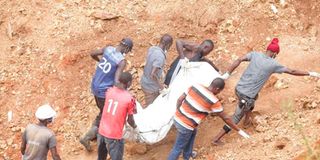Premium
60 mine accident deaths recorded

Rescuers carry the body of Tom Okwach, a miner who had been trapped for close to seven months at a mining site at Abimbo village in Sakwa Bondo in Siaya County on June 26, 2022.
At least 60 people have died in mining sites in four counties over the past six years, a new report exposing Kenya’s deadly mines shows, while indicating the death toll could be higher as some fatalities are covered up to protect the businesses.
The report by Auditor-General Nancy Gathungu on artisanal mining operations reveals that Kakamega, Kisumu and Migori lead in the number of reported deaths between July 2016 and June last year. It further reveals that more people could be dying at the gold, gemstone, sand and quarry mines across the country, but the deaths are going unreported as miners fear such reports could lead to closures.
“For the period 2016/17 to 2021/22, there were a total of 60 deaths reported; 27 in Kakamega, 15 in Migori and Kisumu each, and three in Taita-Taveta. Further, interviews with RMOs (regional mining officers) revealed that some deaths were not reported as miners feared that operations in the mines would be negatively affected,” the Auditor-General states in the Performance Audit Report on Monitoring of Artisanal Mining Operations by the Ministry of Petroleum and Mining.
The report shows that the ministry has been unable to monitor mining operations effectively due to challenges that include shortage of staff, underfunding and delays in implementation of some policies. This has left the sector, estimated to employ about 140,000 people directly and 800,000 indirectly (by 2018), to cause suffering to workers and communities around the mines.
“Despite the importance of artisanal mining in generating income for low-income groups, there have been reports on health, safety and environmental concerns surrounding it. These include incidences of fatal accidents in various mining sites, particularly where gold and gemstones are mined, and the use of mercury in gold mining processes,” Ms Gathungu says.
The report observes that in the four counties, other than the 60 deaths reported, 59 accidents have been reported over the six years, while miners continue to use unsafe means to extract the minerals and disposing of effluent through unsafe means. The audit revealed incidences of handling of mercury with bare hands by miners. “In addition, miners in the sampled regions did not wear gas masks when roasting gold amalgam to separate gold from mercury,” the report states.
Ms Gathungu further reveals that communities living in areas with mining sites could be exposed to dangerous health conditions due to contamination of soils and waters through discharge of harmful effluent into rivers, streams and pans.
The audit recommends the training of artisanal miners on health and safety practices and environmental conservation. It also calls on government agencies to explore alternatives to the use of mercury and harmful chemicals by artisanal miners.





